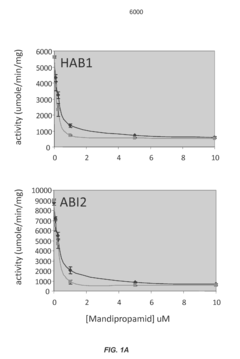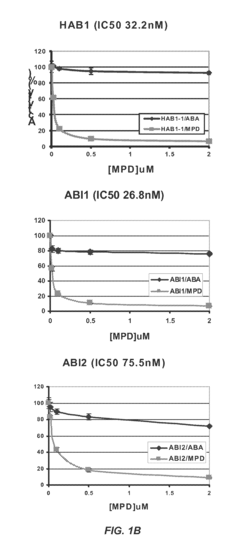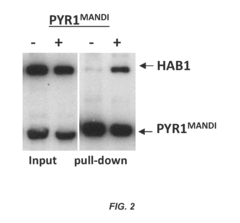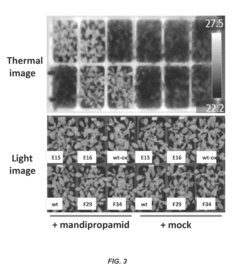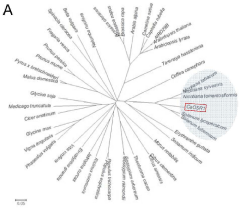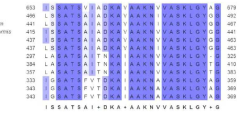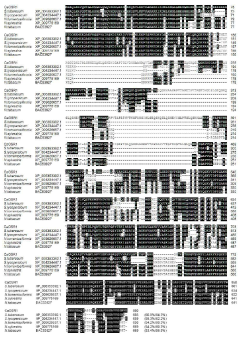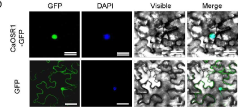How to Use Abscisic Acid for Maximizing Biotic Stress Tolerance?
JUL 14, 20259 MIN READ
Generate Your Research Report Instantly with AI Agent
Patsnap Eureka helps you evaluate technical feasibility & market potential.
ABA and Stress Tolerance
Abscisic acid (ABA) plays a crucial role in plant stress responses, particularly in enhancing biotic stress tolerance. As a key phytohormone, ABA mediates various physiological processes that enable plants to cope with adverse environmental conditions, including pathogen attacks and pest infestations.
ABA's involvement in biotic stress tolerance is multifaceted. It regulates stomatal closure, which not only helps conserve water but also restricts pathogen entry through natural openings. This hormone also induces the expression of defense-related genes, leading to the production of antimicrobial compounds and the reinforcement of cell walls.
The signaling cascade initiated by ABA involves complex interactions with other plant hormones, such as salicylic acid, jasmonic acid, and ethylene. This crosstalk fine-tunes the plant's defense responses, allowing for a more targeted and efficient reaction to specific biotic stressors.
Recent research has shown that exogenous application of ABA can enhance plants' resistance to various pathogens. For instance, pre-treatment with ABA has been found to increase resistance to fungal infections in crops like rice and tomatoes. However, the effectiveness of ABA application depends on factors such as timing, concentration, and the specific pathogen-plant interaction.
Genetic engineering approaches have also been explored to maximize biotic stress tolerance through ABA-mediated pathways. Overexpression of genes involved in ABA biosynthesis or signaling can lead to improved pathogen resistance. Conversely, suppression of negative regulators in the ABA signaling pathway can enhance the plant's defensive capabilities.
It's important to note that while ABA generally promotes biotic stress tolerance, its effects can be context-dependent. In some cases, elevated ABA levels may increase susceptibility to certain pathogens, highlighting the complexity of plant-pathogen interactions and the need for a nuanced approach in utilizing ABA for stress management.
Future research directions include developing ABA analogs with enhanced stability and efficacy, as well as exploring the potential of ABA-priming techniques to induce long-lasting resistance in crops. Additionally, unraveling the intricate molecular mechanisms underlying ABA-mediated biotic stress responses will be crucial for developing more targeted and effective strategies to maximize stress tolerance in plants.
ABA's involvement in biotic stress tolerance is multifaceted. It regulates stomatal closure, which not only helps conserve water but also restricts pathogen entry through natural openings. This hormone also induces the expression of defense-related genes, leading to the production of antimicrobial compounds and the reinforcement of cell walls.
The signaling cascade initiated by ABA involves complex interactions with other plant hormones, such as salicylic acid, jasmonic acid, and ethylene. This crosstalk fine-tunes the plant's defense responses, allowing for a more targeted and efficient reaction to specific biotic stressors.
Recent research has shown that exogenous application of ABA can enhance plants' resistance to various pathogens. For instance, pre-treatment with ABA has been found to increase resistance to fungal infections in crops like rice and tomatoes. However, the effectiveness of ABA application depends on factors such as timing, concentration, and the specific pathogen-plant interaction.
Genetic engineering approaches have also been explored to maximize biotic stress tolerance through ABA-mediated pathways. Overexpression of genes involved in ABA biosynthesis or signaling can lead to improved pathogen resistance. Conversely, suppression of negative regulators in the ABA signaling pathway can enhance the plant's defensive capabilities.
It's important to note that while ABA generally promotes biotic stress tolerance, its effects can be context-dependent. In some cases, elevated ABA levels may increase susceptibility to certain pathogens, highlighting the complexity of plant-pathogen interactions and the need for a nuanced approach in utilizing ABA for stress management.
Future research directions include developing ABA analogs with enhanced stability and efficacy, as well as exploring the potential of ABA-priming techniques to induce long-lasting resistance in crops. Additionally, unraveling the intricate molecular mechanisms underlying ABA-mediated biotic stress responses will be crucial for developing more targeted and effective strategies to maximize stress tolerance in plants.
Market for ABA Applications
The market for abscisic acid (ABA) applications in agriculture and horticulture has been steadily growing, driven by the increasing need for stress-tolerant crops and improved plant performance under adverse conditions. As climate change continues to pose challenges to global agriculture, the demand for ABA-based solutions is expected to rise significantly in the coming years.
In the agricultural sector, ABA applications are primarily focused on enhancing crop resilience to biotic stresses, such as pest infestations and pathogen attacks. Farmers and agribusinesses are increasingly recognizing the potential of ABA to improve crop yields and quality, particularly in regions prone to environmental stresses. This has led to a growing market for ABA-based products, including foliar sprays, seed treatments, and soil amendments.
The horticultural industry has also shown considerable interest in ABA applications, particularly in the production of ornamental plants and high-value crops. Nurseries and greenhouse operators are utilizing ABA to improve plant quality, extend shelf life, and enhance stress tolerance during transportation and retail display. This segment of the market is expected to experience substantial growth as consumers demand higher quality and longer-lasting plants.
Geographically, North America and Europe currently dominate the ABA market, owing to their advanced agricultural practices and stringent regulations on crop protection products. However, emerging economies in Asia-Pacific and Latin America are projected to witness rapid growth in ABA adoption, driven by the need to increase agricultural productivity and combat the effects of climate change on crop production.
The market for ABA applications is characterized by a mix of established agrochemical companies and innovative startups. Major players are investing heavily in research and development to create novel ABA formulations and application methods. This competitive landscape is fostering innovation and driving down costs, making ABA-based solutions more accessible to a wider range of farmers and growers.
Despite the promising outlook, the ABA market faces certain challenges. These include the need for extensive field trials to demonstrate efficacy across various crop types and environmental conditions, as well as regulatory hurdles in some regions. Additionally, educating farmers and growers about the benefits and proper use of ABA-based products remains a crucial factor in market expansion.
As research continues to uncover new applications for ABA in plant stress management, the market is expected to diversify. Emerging areas of interest include the use of ABA in precision agriculture, where it can be integrated with sensor technologies and data analytics to optimize crop performance. Furthermore, the potential of ABA in enhancing nutrient uptake and water use efficiency is likely to open up new market opportunities in sustainable agriculture practices.
In the agricultural sector, ABA applications are primarily focused on enhancing crop resilience to biotic stresses, such as pest infestations and pathogen attacks. Farmers and agribusinesses are increasingly recognizing the potential of ABA to improve crop yields and quality, particularly in regions prone to environmental stresses. This has led to a growing market for ABA-based products, including foliar sprays, seed treatments, and soil amendments.
The horticultural industry has also shown considerable interest in ABA applications, particularly in the production of ornamental plants and high-value crops. Nurseries and greenhouse operators are utilizing ABA to improve plant quality, extend shelf life, and enhance stress tolerance during transportation and retail display. This segment of the market is expected to experience substantial growth as consumers demand higher quality and longer-lasting plants.
Geographically, North America and Europe currently dominate the ABA market, owing to their advanced agricultural practices and stringent regulations on crop protection products. However, emerging economies in Asia-Pacific and Latin America are projected to witness rapid growth in ABA adoption, driven by the need to increase agricultural productivity and combat the effects of climate change on crop production.
The market for ABA applications is characterized by a mix of established agrochemical companies and innovative startups. Major players are investing heavily in research and development to create novel ABA formulations and application methods. This competitive landscape is fostering innovation and driving down costs, making ABA-based solutions more accessible to a wider range of farmers and growers.
Despite the promising outlook, the ABA market faces certain challenges. These include the need for extensive field trials to demonstrate efficacy across various crop types and environmental conditions, as well as regulatory hurdles in some regions. Additionally, educating farmers and growers about the benefits and proper use of ABA-based products remains a crucial factor in market expansion.
As research continues to uncover new applications for ABA in plant stress management, the market is expected to diversify. Emerging areas of interest include the use of ABA in precision agriculture, where it can be integrated with sensor technologies and data analytics to optimize crop performance. Furthermore, the potential of ABA in enhancing nutrient uptake and water use efficiency is likely to open up new market opportunities in sustainable agriculture practices.
Current ABA Research Status
Abscisic acid (ABA) research has made significant strides in recent years, particularly in understanding its role in biotic stress tolerance. Current studies focus on elucidating the molecular mechanisms of ABA signaling and its interaction with other stress response pathways. Researchers have identified key components of the ABA signaling cascade, including receptors, phosphatases, and transcription factors, which are crucial for stress response activation.
One major area of investigation is the cross-talk between ABA and other phytohormones, such as jasmonic acid and salicylic acid, in mediating plant responses to biotic stressors. This research has revealed complex regulatory networks that fine-tune plant defense mechanisms against pathogens and pests. Scientists are exploring how ABA influences the expression of defense-related genes and the production of secondary metabolites that contribute to plant immunity.
Recent advances in genomics and transcriptomics have enabled researchers to identify novel ABA-responsive genes and regulatory elements. These discoveries have expanded our understanding of the ABA-mediated stress response and opened new avenues for genetic engineering to enhance plant resilience. Additionally, studies on ABA biosynthesis and catabolism have provided insights into how plants modulate endogenous ABA levels in response to biotic stress.
The application of ABA in agriculture is another active area of research. Scientists are investigating the potential of exogenous ABA application to boost crop resistance to pathogens and herbivores. Field trials have shown promising results in various crop species, demonstrating improved tolerance to fungal infections and insect infestations. However, challenges remain in optimizing ABA delivery methods and timing to maximize its effectiveness while minimizing potential negative impacts on plant growth and yield.
Emerging research is also exploring the role of ABA in priming plant defense responses. This phenomenon, known as stress memory or defense priming, allows plants to respond more rapidly and effectively to subsequent stress events. Understanding how ABA contributes to this process could lead to novel strategies for enhancing long-term stress resilience in crops.
Furthermore, recent studies have begun to unravel the epigenetic regulation of ABA-mediated stress responses. Researchers are investigating how histone modifications and DNA methylation patterns influence ABA signaling and gene expression during biotic stress. This research has the potential to reveal new targets for improving plant stress tolerance through epigenetic manipulation.
One major area of investigation is the cross-talk between ABA and other phytohormones, such as jasmonic acid and salicylic acid, in mediating plant responses to biotic stressors. This research has revealed complex regulatory networks that fine-tune plant defense mechanisms against pathogens and pests. Scientists are exploring how ABA influences the expression of defense-related genes and the production of secondary metabolites that contribute to plant immunity.
Recent advances in genomics and transcriptomics have enabled researchers to identify novel ABA-responsive genes and regulatory elements. These discoveries have expanded our understanding of the ABA-mediated stress response and opened new avenues for genetic engineering to enhance plant resilience. Additionally, studies on ABA biosynthesis and catabolism have provided insights into how plants modulate endogenous ABA levels in response to biotic stress.
The application of ABA in agriculture is another active area of research. Scientists are investigating the potential of exogenous ABA application to boost crop resistance to pathogens and herbivores. Field trials have shown promising results in various crop species, demonstrating improved tolerance to fungal infections and insect infestations. However, challenges remain in optimizing ABA delivery methods and timing to maximize its effectiveness while minimizing potential negative impacts on plant growth and yield.
Emerging research is also exploring the role of ABA in priming plant defense responses. This phenomenon, known as stress memory or defense priming, allows plants to respond more rapidly and effectively to subsequent stress events. Understanding how ABA contributes to this process could lead to novel strategies for enhancing long-term stress resilience in crops.
Furthermore, recent studies have begun to unravel the epigenetic regulation of ABA-mediated stress responses. Researchers are investigating how histone modifications and DNA methylation patterns influence ABA signaling and gene expression during biotic stress. This research has the potential to reveal new targets for improving plant stress tolerance through epigenetic manipulation.
ABA-based Stress Solutions
01 Enhancing plant stress tolerance using abscisic acid
Abscisic acid (ABA) plays a crucial role in enhancing plant tolerance to various biotic stresses. By manipulating ABA biosynthesis, signaling, or response pathways, plants can be engineered to better withstand environmental challenges such as pathogen attacks or pest infestations. This approach involves genetic modifications or exogenous application of ABA to improve plant resilience.- Enhancing plant stress tolerance using abscisic acid: Abscisic acid (ABA) plays a crucial role in enhancing plant tolerance to various biotic stresses. By modulating ABA biosynthesis, signaling, or response pathways, plants can better withstand pathogen attacks and other biotic stressors. This approach involves genetic modification or exogenous application of ABA to improve plant resilience.
- ABA-responsive gene expression for stress tolerance: Identifying and manipulating ABA-responsive genes can lead to improved biotic stress tolerance in plants. This involves studying gene expression patterns under stress conditions and developing transgenic plants with enhanced expression of key ABA-responsive genes, resulting in better defense mechanisms against pathogens and pests.
- ABA signaling pathway modification for stress resistance: Modifying the ABA signaling pathway can enhance plant resistance to biotic stresses. This includes altering ABA receptors, transcription factors, or downstream signaling components to amplify the plant's stress response. Such modifications can lead to improved pathogen resistance and overall plant health under stress conditions.
- Combining ABA with other phytohormones for stress management: Integrating ABA with other plant hormones, such as jasmonic acid or salicylic acid, can create synergistic effects in managing biotic stress. This approach involves studying hormone crosstalk and developing strategies to optimize the balance between different hormones for enhanced stress tolerance.
- ABA-mediated priming for improved stress response: Priming plants with ABA or ABA-related compounds can enhance their ability to respond quickly and effectively to biotic stresses. This technique involves pre-treating plants or seeds with ABA to activate stress response mechanisms, resulting in faster and more robust defense responses when actual stress occurs.
02 ABA-responsive gene expression for stress tolerance
Identifying and modifying ABA-responsive genes can lead to improved biotic stress tolerance in plants. This involves studying gene expression patterns under stress conditions and manipulating key genes involved in ABA signaling or stress response. By enhancing the expression of beneficial genes or suppressing detrimental ones, plants can be made more resilient to biotic stresses.Expand Specific Solutions03 ABA signaling pathway modifications for stress resistance
Altering components of the ABA signaling pathway can enhance plant resistance to biotic stresses. This may involve modifying receptors, transcription factors, or other signaling molecules to amplify or fine-tune the plant's response to stress. Such modifications can lead to more efficient stress detection and response mechanisms in plants.Expand Specific Solutions04 Combining ABA with other phytohormones for stress management
Integrating ABA with other plant hormones can create synergistic effects in managing biotic stress. This approach involves studying the interactions between ABA and hormones like jasmonic acid or salicylic acid, which are also involved in stress responses. By optimizing these hormone combinations, plants can be made more resilient to a broader range of biotic stresses.Expand Specific Solutions05 ABA-mediated priming for enhanced stress tolerance
Priming plants with ABA can enhance their ability to respond to future biotic stresses. This involves exposing plants to controlled levels of ABA or stress, which activates defense mechanisms and prepares the plant for potential future challenges. Primed plants often show faster and stronger responses to subsequent stresses, improving their overall tolerance and survival.Expand Specific Solutions
Key ABA Research Institutes
The competitive landscape for using abscisic acid to maximize biotic stress tolerance is in a growth phase, with increasing market size and advancing technological maturity. The market is driven by the growing demand for sustainable agricultural solutions. Key players include established agrochemical companies like BASF, Syngenta, and Bayer CropScience, as well as specialized biotechnology firms such as Evogene and Valent BioSciences. Academic institutions like the University of California and China Agricultural University are also contributing to research and development. The technology is progressing from basic research to applied solutions, with companies focusing on optimizing abscisic acid formulations and delivery methods for various crops and stress conditions.
Evogene Ltd.
Technical Solution: Evogene Ltd. has developed a comprehensive approach to utilizing abscisic acid (ABA) for enhancing biotic stress tolerance in plants. Their technology platform, called Gene2Product™, integrates computational biology and big data analytics to identify key genes and biological pathways involved in ABA-mediated stress responses[1]. The company has engineered plants with optimized ABA signaling pathways, resulting in improved drought tolerance and resistance to various pathogens[2]. Evogene's approach includes fine-tuning ABA biosynthesis, catabolism, and signal transduction to achieve a balanced stress response without compromising plant growth and yield[3]. They have also developed novel ABA analogs with enhanced stability and efficacy, which can be applied as foliar sprays or seed treatments to boost crop resilience[4].
Strengths: Comprehensive gene discovery platform, tailored ABA-based solutions for different crops, and integration of computational and biological approaches. Weaknesses: Potential regulatory hurdles for genetically modified crops and the need for extensive field trials to validate efficacy across diverse environments.
Valent BioSciences Corp.
Technical Solution: Valent BioSciences Corp. has pioneered the development of s-ABA (synthetic abscisic acid) as a plant growth regulator to enhance biotic stress tolerance. Their proprietary formulation, marketed under the brand name ProTone®, is designed for exogenous application to crops[1]. The company's approach focuses on precise timing and dosage of s-ABA application to activate plant defense mechanisms against various biotic stresses, including fungal and bacterial pathogens[2]. Valent BioSciences has conducted extensive field trials demonstrating that s-ABA treatment can significantly improve plant immune responses and reduce disease incidence in high-value crops such as fruits and vegetables[3]. Their research has also shown that s-ABA application can enhance the efficacy of conventional pesticides, allowing for reduced chemical inputs in integrated pest management programs[4].
Strengths: Commercially available s-ABA product, extensive field trial data, and compatibility with existing agricultural practices. Weaknesses: Potential variability in efficacy due to environmental factors and the need for precise application timing.
ABA Receptor Innovations
Modified PYR/PYL receptors activated by ligands
PatentActiveUS20160115500A1
Innovation
- Development of mutated PYR/PYL receptor polypeptides that are agonized by chemicals like mandipropamid, dichlobenil, benzothiadiazole, benoxacor, and fludioxonil, which do not activate wild-type receptors, allowing for selective activation of stress tolerance pathways only under stress conditions, thereby avoiding yield drag.
Method for improving the resistance to the abiotic stresses using CaOSR1 in plants
PatentActiveKR1020170104059A
Innovation
- The CaOSR1 (Capsicum annuum Osmotic Stress Resistance 1) gene is isolated and overexpressed in plants, enhancing their resistance to abiotic stresses by increasing ABA sensitivity and regulating stress responses.
Environmental Impact
The use of abscisic acid (ABA) for maximizing biotic stress tolerance in plants has significant environmental implications. As a plant hormone, ABA plays a crucial role in regulating plant responses to various environmental stresses, including biotic stresses caused by pathogens and pests. By enhancing plants' natural defense mechanisms, ABA-based strategies can potentially reduce the reliance on synthetic pesticides and fungicides, leading to more sustainable agricultural practices.
One of the primary environmental benefits of using ABA for biotic stress tolerance is the potential reduction in chemical inputs. Conventional pest and disease management often relies heavily on synthetic pesticides, which can have detrimental effects on non-target organisms, soil health, and water quality. By enhancing plants' innate resistance through ABA-mediated pathways, farmers may be able to significantly reduce their use of these chemicals, thereby minimizing environmental contamination and preserving biodiversity in agricultural ecosystems.
Furthermore, the application of ABA or ABA-mimicking compounds can lead to improved resource use efficiency in crop production. Plants with enhanced biotic stress tolerance are likely to maintain better growth and productivity under challenging conditions, potentially reducing the need for additional irrigation or fertilization. This can contribute to water conservation and decreased nutrient runoff, which are critical factors in mitigating environmental degradation and eutrophication of water bodies.
The use of ABA for biotic stress tolerance may also have positive implications for climate change adaptation. As global temperatures rise and weather patterns become more erratic, plants are increasingly exposed to multiple stresses simultaneously. ABA's role in mediating cross-tolerance to various stresses, including both biotic and abiotic factors, could help develop more resilient crop varieties that can withstand the complex challenges posed by a changing climate.
However, it is essential to consider potential ecological risks associated with widespread ABA application. Altering plant hormone levels could have unintended consequences on plant-insect interactions, potentially disrupting pollination services or natural pest control mechanisms. Additionally, the long-term effects of ABA-based treatments on soil microbial communities and ecosystem dynamics require thorough investigation to ensure that these strategies do not negatively impact overall environmental health.
In conclusion, while the use of ABA for maximizing biotic stress tolerance shows promise for reducing environmental impacts associated with conventional agricultural practices, a comprehensive assessment of its ecological effects is necessary. Balancing the potential benefits of enhanced crop resilience with the need to maintain ecosystem integrity will be crucial in developing sustainable ABA-based strategies for plant protection and agricultural productivity.
One of the primary environmental benefits of using ABA for biotic stress tolerance is the potential reduction in chemical inputs. Conventional pest and disease management often relies heavily on synthetic pesticides, which can have detrimental effects on non-target organisms, soil health, and water quality. By enhancing plants' innate resistance through ABA-mediated pathways, farmers may be able to significantly reduce their use of these chemicals, thereby minimizing environmental contamination and preserving biodiversity in agricultural ecosystems.
Furthermore, the application of ABA or ABA-mimicking compounds can lead to improved resource use efficiency in crop production. Plants with enhanced biotic stress tolerance are likely to maintain better growth and productivity under challenging conditions, potentially reducing the need for additional irrigation or fertilization. This can contribute to water conservation and decreased nutrient runoff, which are critical factors in mitigating environmental degradation and eutrophication of water bodies.
The use of ABA for biotic stress tolerance may also have positive implications for climate change adaptation. As global temperatures rise and weather patterns become more erratic, plants are increasingly exposed to multiple stresses simultaneously. ABA's role in mediating cross-tolerance to various stresses, including both biotic and abiotic factors, could help develop more resilient crop varieties that can withstand the complex challenges posed by a changing climate.
However, it is essential to consider potential ecological risks associated with widespread ABA application. Altering plant hormone levels could have unintended consequences on plant-insect interactions, potentially disrupting pollination services or natural pest control mechanisms. Additionally, the long-term effects of ABA-based treatments on soil microbial communities and ecosystem dynamics require thorough investigation to ensure that these strategies do not negatively impact overall environmental health.
In conclusion, while the use of ABA for maximizing biotic stress tolerance shows promise for reducing environmental impacts associated with conventional agricultural practices, a comprehensive assessment of its ecological effects is necessary. Balancing the potential benefits of enhanced crop resilience with the need to maintain ecosystem integrity will be crucial in developing sustainable ABA-based strategies for plant protection and agricultural productivity.
ABA Regulatory Framework
The ABA regulatory framework plays a crucial role in understanding and maximizing biotic stress tolerance in plants. Abscisic acid (ABA) is a key phytohormone involved in various physiological processes, including stress responses. The regulatory framework encompasses the complex network of genes, proteins, and signaling pathways that control ABA biosynthesis, perception, and downstream responses.
At the core of the ABA regulatory framework are the ABA receptors, primarily the PYR/PYL/RCAR family. These receptors interact with protein phosphatases (PP2Cs) and SNF1-related protein kinases (SnRK2s) to form a tripartite signaling complex. In the presence of ABA, the receptors bind to and inhibit PP2Cs, allowing SnRK2s to become active and phosphorylate downstream targets, including transcription factors and ion channels.
The ABA-responsive element binding factors (ABFs) are key transcription factors in the ABA signaling pathway. These bZIP-type transcription factors bind to ABA-responsive elements (ABREs) in the promoter regions of ABA-inducible genes, activating their expression. This leads to the production of various stress-responsive proteins, such as dehydrins, late embryogenesis abundant (LEA) proteins, and antioxidant enzymes.
Upstream of ABA signaling, the biosynthesis of ABA is regulated by a series of enzymes, including 9-cis-epoxycarotenoid dioxygenase (NCED), which catalyzes a rate-limiting step in ABA production. The expression of NCED genes is often induced by biotic stress, leading to increased ABA levels and subsequent activation of stress responses.
The ABA regulatory framework also includes various feedback mechanisms and crosstalk with other hormonal pathways. For instance, ABA signaling can modulate the biosynthesis and signaling of other stress-related hormones like jasmonic acid and salicylic acid, fine-tuning the plant's response to different types of biotic stress.
Recent research has revealed additional layers of complexity in the ABA regulatory framework, including epigenetic regulation and post-translational modifications of key components. These mechanisms allow for rapid and dynamic adjustments to ABA responses, enabling plants to adapt to changing environmental conditions and biotic stress challenges.
Understanding the intricacies of the ABA regulatory framework is essential for developing strategies to enhance biotic stress tolerance in plants. By manipulating key components of this framework, such as overexpressing ABA receptors or modifying the activity of transcription factors, researchers can potentially improve plant resilience to various pathogens and pests.
At the core of the ABA regulatory framework are the ABA receptors, primarily the PYR/PYL/RCAR family. These receptors interact with protein phosphatases (PP2Cs) and SNF1-related protein kinases (SnRK2s) to form a tripartite signaling complex. In the presence of ABA, the receptors bind to and inhibit PP2Cs, allowing SnRK2s to become active and phosphorylate downstream targets, including transcription factors and ion channels.
The ABA-responsive element binding factors (ABFs) are key transcription factors in the ABA signaling pathway. These bZIP-type transcription factors bind to ABA-responsive elements (ABREs) in the promoter regions of ABA-inducible genes, activating their expression. This leads to the production of various stress-responsive proteins, such as dehydrins, late embryogenesis abundant (LEA) proteins, and antioxidant enzymes.
Upstream of ABA signaling, the biosynthesis of ABA is regulated by a series of enzymes, including 9-cis-epoxycarotenoid dioxygenase (NCED), which catalyzes a rate-limiting step in ABA production. The expression of NCED genes is often induced by biotic stress, leading to increased ABA levels and subsequent activation of stress responses.
The ABA regulatory framework also includes various feedback mechanisms and crosstalk with other hormonal pathways. For instance, ABA signaling can modulate the biosynthesis and signaling of other stress-related hormones like jasmonic acid and salicylic acid, fine-tuning the plant's response to different types of biotic stress.
Recent research has revealed additional layers of complexity in the ABA regulatory framework, including epigenetic regulation and post-translational modifications of key components. These mechanisms allow for rapid and dynamic adjustments to ABA responses, enabling plants to adapt to changing environmental conditions and biotic stress challenges.
Understanding the intricacies of the ABA regulatory framework is essential for developing strategies to enhance biotic stress tolerance in plants. By manipulating key components of this framework, such as overexpressing ABA receptors or modifying the activity of transcription factors, researchers can potentially improve plant resilience to various pathogens and pests.
Unlock deeper insights with Patsnap Eureka Quick Research — get a full tech report to explore trends and direct your research. Try now!
Generate Your Research Report Instantly with AI Agent
Supercharge your innovation with Patsnap Eureka AI Agent Platform!
